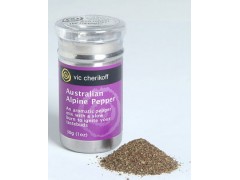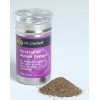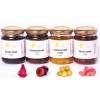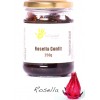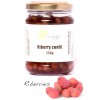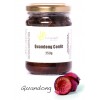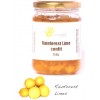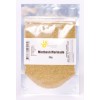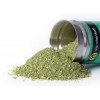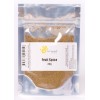COLOR - olive and pastel green herb pieces with dark purple flecks of fruits of the spices; sumac and pepperberries
AROMA - woody peppery note with a hint of fruit
PALATE - herbaceous short palate with conventional pepper zing then exhibiting an increasing burn with rich berry and a hint of green tea
You may think that you have tried all the varieties of pepper already but here is a totally new one. Sure. There's black, grey and white pepper as well as green, pink and red pepper which all come from the same plant (a climber, originally from India). You may have even tried betel pepper, Indian long or Javan long peppers or the rough-leaved pepper - all are different species of the same genus, Piper.
However, here in Australia, we have a totally new type of pepper which is more closely related to the source of aspirin or oil of Wintergreen than to the tropical true pepper vine. We call it mountain pepper and it's actually a herb although the berries we call pepperberries are also used - sparingly. I say this because chewing on a few pepperberries is like having a grenade go off in your mouth.
I also include a specially prepared, encapsulated extract of the leaves which imparts that instant zing of bushy heat. There's some forest anise, which not only ideally complements the taste but adds to some serious functionality in that the combination is super-strongly anti-microbial so that there is some preservative action when using Alpine pepper as a marinade. Finally, I have added some of the tangy, Turkish sumac for its fruitiness to enhance the pepperberries and some conventional Piper corns in their black and white forms are added for those familiar pepper notes.
You'll grab for the Alpine pepper as most cooks would for a peppermill. It can easily and deliciously substitute for ordinary pepper on meats, seafood, soups, vegetables, eggs and cheese dishes. Use it to taste and you'll discover that Wow! factor you want in your food.
Alpine pepper can also be used in far more ways than just as a seasoning over cooked dishes. Use it as a dry marinade on meats or add it to breads, batter and pastry as a herb mix. It makes the best salt and pepper squid you'll ever try.
Now here's something I discovered by accident - Try sprinkling Alpine pepper over raw or cooked fruit or mix it into ice cream (particularly strawberry flavoured), yoghurt, cream cheese or custards. Alternatively, generously season peeled and sliced bananas with Alpine pepper and pan-fry them in butter and a dash of your favorite oil (olive, macadamia, avocado, walnut, pumpkin seed, whatever) until they just brown and soften. Serve with ice cream and a small cup of strong coffee.
By the way, I store my Alpine pepper on the door of my freezer. It keeps the aromatics fresh and is always at hand so it won't go the way of less valued spices which get buried and lost or just forgotten in the pantry.


